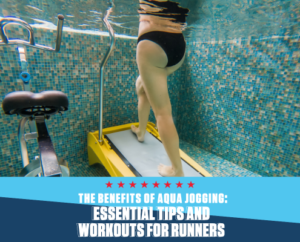THE BENEFITS OF AQUA JOGGING: ESSENTIAL TIPS AND WORKOUTS FOR RUNNERS
Aqua jogging is more than just a fun way to break a sweat. It’s a game-changing exercise method, especially for runners. Whether you’re a seasoned marathoner, an occasional jogger, or recovering from an injury, aqua jogging might be the missing piece in your fitness routine.
Benefits of Aqua Jogging
- Low Impact: Water provides buoyancy, which reduces the impact on joints. This makes aqua jogging an excellent option for those with joint problems or those who are recovering from injuries.
- Effective Cardio Workout: The resistance from the water ensures that your heart rate is elevated, similar to traditional running.
- Strength Training: Moving against the water isn’t just good for your heart—it also tones and strengthens muscles.
- Flexibility: The water’s resistance aids in the development of a greater range of motion in your limbs, thereby improving flexibility.
- Therapeutic: The soothing properties of water can be incredibly calming, making your workout as beneficial for your mind as it is for your body.
Now, if you’re considering adding aqua jogging to your routine, there are certain tips that can maximize the benefits and ensure a safe and effective workout.
5 Essential Aqua Jogging Tips for Runners
- Get the Right Gear: While you can aqua jog without any gear, a flotation belt will help keep you upright and simulate the running motion better. This ensures you’re targeting the right muscles and maintaining proper posture.
- Maintain Proper Form: Aim for an upright position. Your arms should move as they would during land-based running—bending at the elbow and swinging forward and back. Drive your knees up, mimicking a high-knee running motion.
- Use the Deep End: The beauty of aqua jogging is the reduced impact. To fully benefit from this, ensure you’re in the deep end so your feet aren’t touching the pool floor. This ensures maximum buoyancy and resistance.
- Stay Consistent: Like any workout, consistency is key. Aim for regular sessions, whether it’s a few times a week or daily, depending on your fitness goals.
- Mix It Up: Incorporate interval training or resistance exercises to make the most of your time in the water.
Ready to dive in? Let’s get moving with these aqua jogging workouts tailored for both beginners and more advanced athletes.
Workout 1: Beginner’s Aqua Jog
- Warm-up (5 minutes):Start with a gentle water walk, slowly increasing your pace until you’re mimicking a light jog.
- Intervals (20 minutes):
– 1 minute of high-intensity aqua jogging, driving your knees high and pumping your arms.
– 1 minute of relaxed pace aqua jogging.
– Repeat for a total of 10 sets. - Cool Down (5 minutes): Gradually slow your pace, transitioning from a jog back to a walk, focusing on deep breathing and relaxing your muscles.
Workout 2: Advanced Aqua Jogging Intervals
- Warm-up (5 minutes): Start with a moderate-paced aqua jog.
- Intervals (30 minutes):
– 2 minutes of high-intensity aqua jogging, emphasizing strong arm movements and high knees.
– 1 minute of easy aqua jogging.
– Repeat for a total of 10 sets. - Strength & Flexibility (10 minutes):
– Aqua Lunges (2 minutes): Step forward in a lunge motion, pushing against the water’s resistance. Alternate legs.
– Side Leg Lifts (2 minutes each side): While standing upright, lift one leg out to the side against the water resistance. Switch sides after 1 minute.
– Aqua Skips (4 minutes): Mimic a skipping motion, driving your knee up and then switching to the other leg in a rhythmic fashion. - Cool Down (5 minutes): Ease into a gentle aqua walk, focusing on stretching out your limbs and slowing down your heart rate.
Aqua jogging isn’t just an alternative to land-based running; it’s a comprehensive workout on its own. Whether you’re using it for cross-training, rehabilitation, or just for a change of pace, its myriad benefits can elevate your overall fitness. Dive in, and you might just find your new favorite way to stay fit.



